Check the piston seal, boot, and pin insulators for wear and damage.
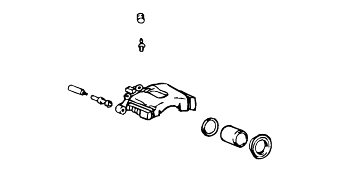
Remove the wheel.
Remove the guide bolt, lift up the caliper assembly, and remove the pad assembly.
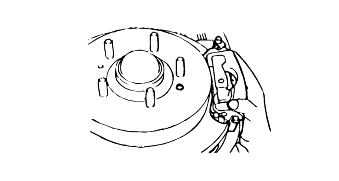
Remove the rear wheel.
Remove the caliper assembly.
Remove the brake hose from the caliper assembly.
Remove the pad.
Remove the piston boot from the housing, and remove the piston.
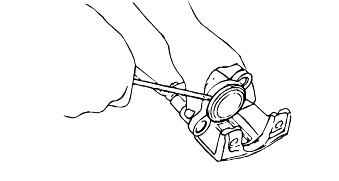
Remove the piston by applying compressed air through the brake hose fitting.
Do not place your fingers in front of the piston when using compressed air.
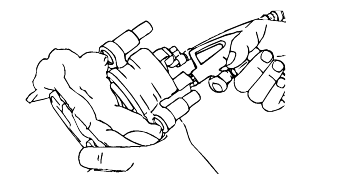
Using a screwdriver, remove the piston seal carefully so as not to damage the cylinder wall.
Clean all removed parts with the specified fluid.
ITEM | SPECIFIED FLUID |
Metal section | Alcohol or brake fluid |
Piston seal | If the oil level is low, add fluid (about 70cc). |
Piston boot and other rubber part | Alcohol |
Rubber parts should be replaced with new ones but if you want to reuse them, don't put them in alcohol for more thanthirty minutes.
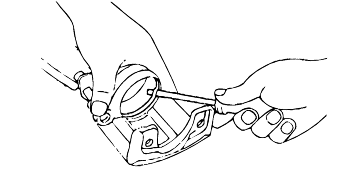
Refer to "Installation"page BR-17.
Perform a road test.
If there is a small quantity of air in the brake line, it can affect the brake pedal stroke so you must bleed the system carefully.
When replacing the piston seal, check the pedal stroke.
If the pedal stroke is too great, the piston may not retain the piston seal.
Adjust as follows :
After removing the pad from the piston, push the piston into the cylinder 3-5mm. Put a lever or steel plate between the piston and disc, being carefulnot to damage the contact surface of the disc or the piston end.
Install the pad. Restore the brake pedal to the original position and step on it 2-3 times.
Repeat the above procedure more than 5 times and move the piston outward and inward to assure that the piston seal is properly installed.
Before driving a vehicle, step on the brake pedal and release it many times.
Perform the road test.
Remove the wheel.
Remove the caliper assembly from the anchor plate and suspend it with a wire.
After loosening the 2 screws on the disc, remove the disc.
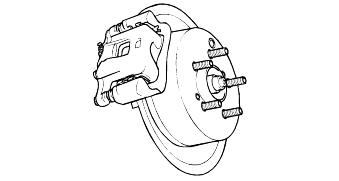
Before replacing the brake pads, drain brake fluid from the master cylinder reservoir until it is half full.
Install two caliper guide rods and tighten to the specified torque.
Specified torque : |
22-32 Nm (220-320 kg.cm, 16.2-23.6 lb.ft) |
After filling the master cylinder reservoir with the fluid, bleed the brake line.
Recommended brake fluid : DOT 3, DOT 4 |
Remove the piston boot/piston.
Wrap the caliper body with a rag. Blow compressed air into the brake hose, opening and remove the piston and the piston boot.
Blow air slowly.
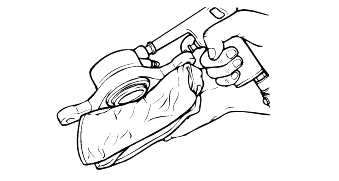
Remove the piston seal.
Remove the piston seal with your finger.
Do not use a screwdriver or another tool in order to avoid damage inside the cylinder.
Clean the piston surface and the inside of the cylinder using alcohol or the specified brake fluid.
Brake fluid : DOT 3 or DOT 4 |
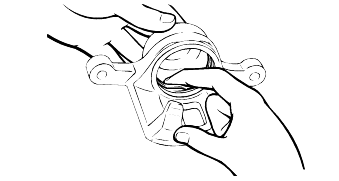
Check the pads for wear or oil contamination and replace if necessary.
The pads for the right and left wheels should be replaced at the same time.
Pad thickness wear limit : 2.0mm (0.08 in.) |
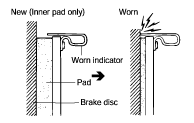
Check for worn or damaged dust boots. If dust or mud had entered the caliper assembly through this seal, the caliper assembly must be replacedor rebuilt.
Check the piston and its inside for wear, damage and rust.
Replace the damaged parts if necessary.
Check the piston seal, boot, and pin insulators for wear and damage.

ITEMS | Standard value | Service limit |
Thickness of disc | 10mm (0.39 in.) | mm (0.33 in.) |
Runout | - | 0.04mm (0.0016 in.) |
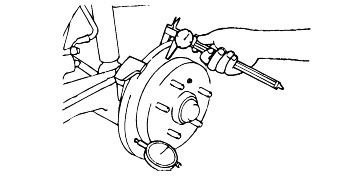
When disassembling the caliper assembly, use a new piston seal and boot.
Apply the recommended fluid to the bearing part of the piston seal and piston. Insert the piston seal into grooves inside the caliper, beingcareful not to twist the seal.
Description | Recommended fluid | Quantity |
Piston seal | Brake fluid (DOT3, DOT4) | As required |
Inside of piston cylinder | Brake fluid (DOT3, DOT4) | As required |
Piston boot | Brake fluid (DOT3, DOT4) | As required |
Locating pin insulator | White silicone grease | As required |
Install the piston boot to the piston.
Confirm that the concave part of the piston is situated outward and the boot fits in grooves of the piston well.

Install the piston and boot in the caliper housing. Insert the boot flange in the caliper housing and check that the boot fits in grooves aroundthe piston.
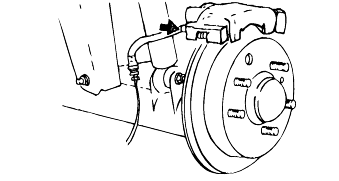
Apply the recommended oil to the inside of the locating pin insulator.
Check the pads for wear or oil contamination and replace if necessary.
The pads for the right and left wheels should be replaced at the same time.
Pad thickness wear limit : 2.0mm (0.08 in.) |

Check for worn or damaged dust boots. If dust or mud had entered the caliper assembly through this seal, the caliper assembly must be replacedor rebuilt.
Check the piston and its inside for wear, damage and rust.
Replace the damaged parts if necessary.
Check the piston seal, boot, and pin insulators for wear and damage.

ITEMS | Standard value | Service limit |
Thickness of disc | 10mm (0.39 in.) | mm (0.33 in.) |
Runout | - | 0.04mm (0.0016 in.) |
